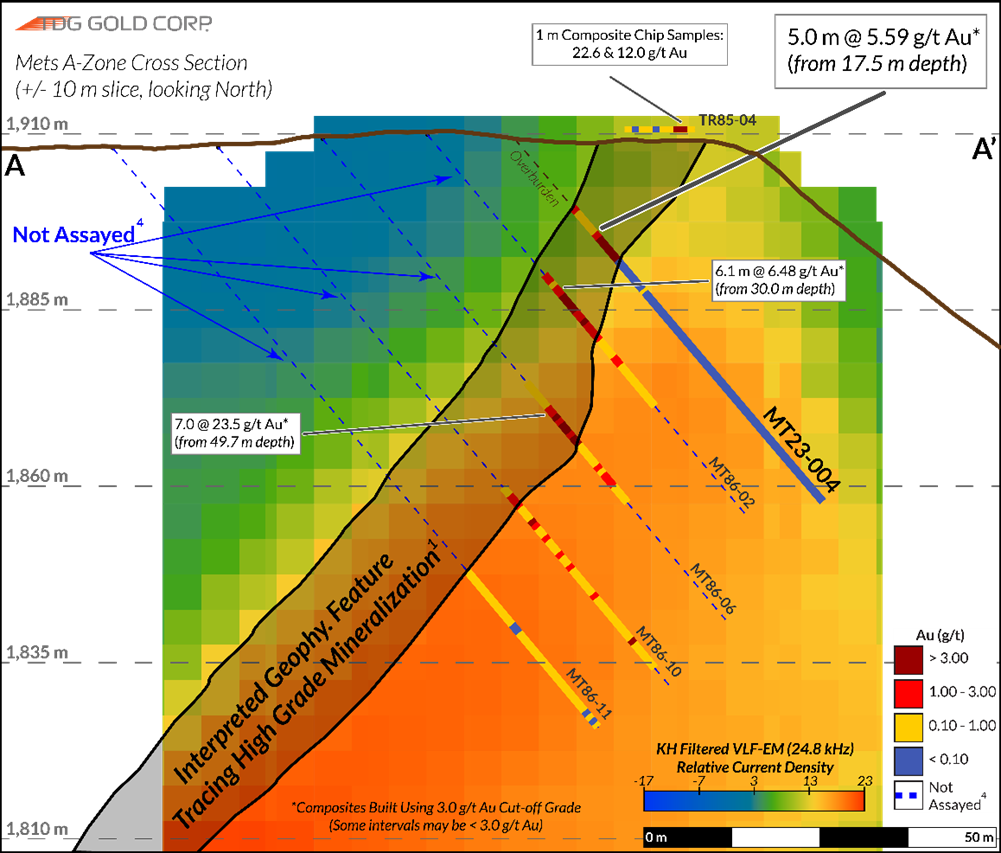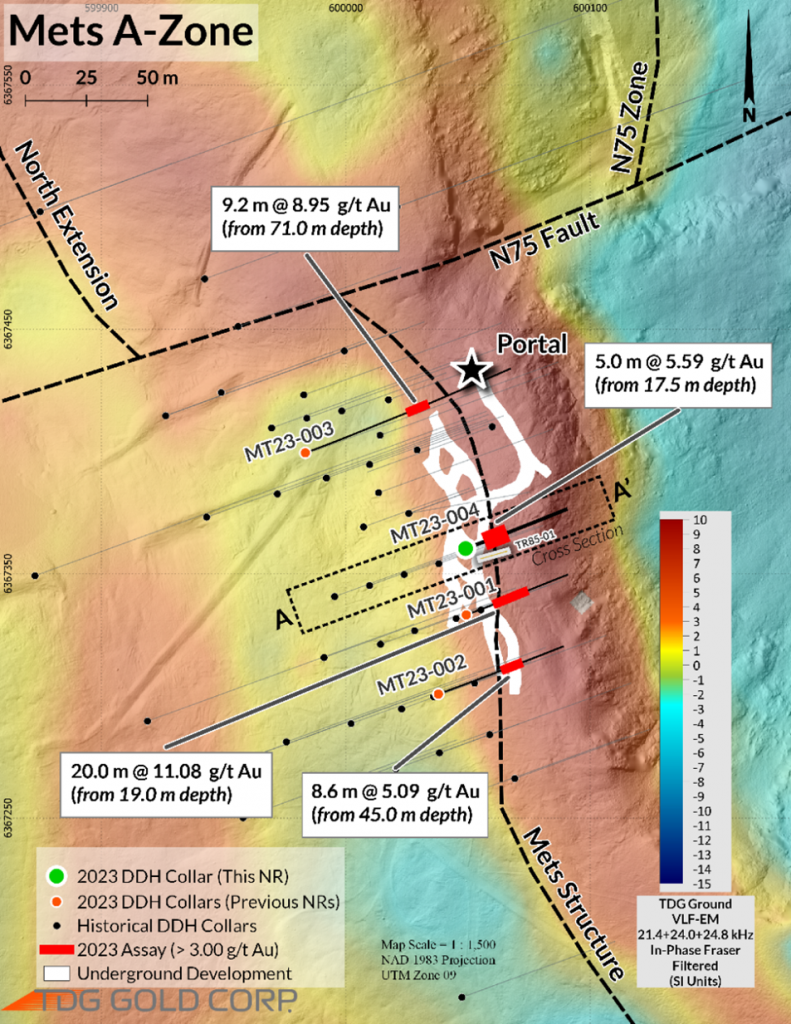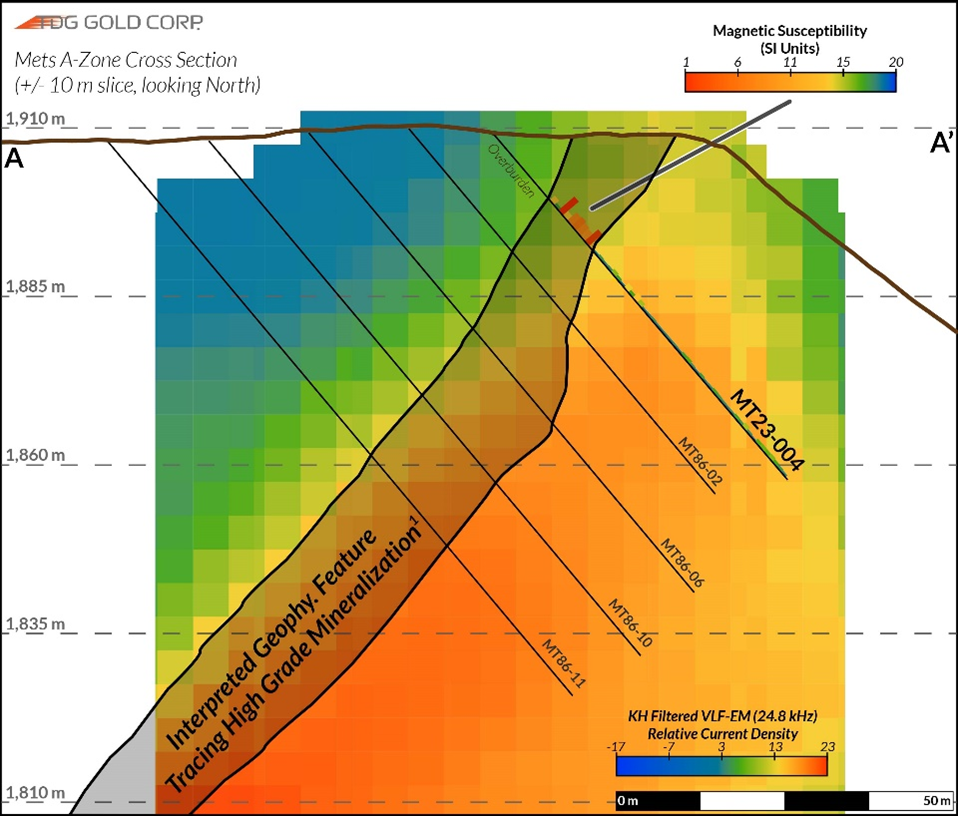TDG GOLD INTERSECTS 5.0 M OF 5.6 G/T GOLD FROM 17.5 M DEPTH AT METS, TOODOGGONE
White Rock, British Columbia, November 28, 2023. TDG Gold Corp (TSXV: TDG) (the “Company” or “TDG”) is pleased to report further higher-grade, near-surface gold (“Au”) mineralization intersected in an additional diamond drillhole as well as the first interpretations from post-processing of an extensive geophysical survey (news release Nov 14, 2023) at TDG’s 100 % owned Mets mining lease, located in the Toodoggone District of north-central B.C.
Diamond drillhole MT23-004 (HQ, oriented) was completed in the Mets A-Zone1 and intersected:
- 5.59 grams per tonne (“g/t”) Au, 2 g/t silver (“Ag”) over 5.0 metres (“m”) from 17.5 m downhole depth, using a cut off grade of 3.00 g/t Au.
The high-grade Au mineralization in the A-Zone appears to be coincident with a strong very low frequency-electromagnetic (“VLF”) feature (Figure 1) in addition to a magnetic susceptibility low (Figure 3), which may assist in targeting additional mineralization. Diamond drillhole MT23-004 was designed to test for mineralization to the east of the previously known extent of the Mets A-Zone1 (Figure 2) and to the north of the very high-grade intercept in hole MT23-001, which intercepted 11 g/t Au over 20 m (news release Sept 07, 2023). Based on historical2 trenching, this shallow mineralization appears to extend right to surface.
Steven Kramar, TDG’s VP Exploration, commented: “The conductive feature picked up by our VLF survey appears to closely correlate with the high-grade Au mineralization. This feature has not been tested to depth and much of the core historically2,3 drilled through the feature was unassayed4 and may contain unidentified Au mineralization. We’re awaiting overlimit assays for the final hole from our 2023 field program at Mets and, once received, we will then begin to generate targets within the priority trends to the north1 and south1 of the A-Zone1.”

Table 1. Assay results from Mets A-Zone1 drillhole MT23-004.
| Hole | From (m) | To (m) | Interval (m) | Au (g/t) | Ag (g/t) |
| MT23-004 | 17.5 | 22.5 | 5.0 | 5.59 | 2 |
** Composite result was built using 3.0 g/t Au cut-off, although there may be intervals within the composite below 3.0 g/t Au.
*** Calculated composite is truncated to significant 2 decimal places for Au and the nearest integer for Ag.
**** Calculated composite may not sum due to rounding.

Mineralization Encountered
Drillhole MT23-004 is interpreted to have intersected the same mineralization as MT23-001 (news release Sept 07, 2023) and MT23-002/MT23-003 (news release Sept 11, 2023). MT23-004 reported high-grade Au-hosted in hydrothermal quartz-barite breccia, similar in style to that intercepted in the other three 2023 holes and demonstrates potential to expand on the high-grade A-Zone. This drillhole further confirms the high-grade nature of the Mets A-Zone and helps demonstrate the continuity of the mineralization across the currently known 130 m strike-length.
MT23-004
MT23-004 was designed to evaluate the near surface expression of the Mets high-grade Au mineralization. Mineralization was intersected just below the overburden and underlying regolith material. The first drill core sample taken in competent rock returned 2.66 g/t Au, 17 g/t Ag over 0.9 m from 12.7 m downhole depth. Overburden and regolith material has also been sent for analytical testing. Historical2 trenching up dip of MT23-004 (TR85-04 –Figure 1) reported results ranging from 0.04 – 22.60 g/t Au in 1 m composite chip sampling over 10 m of the trench-length sampled. This suggests the Mets high-grade structure projects to surface, just below shallow talus cover.
Magnetics / VLF-EM Results Interpretation
Figure 1 presents a cross section of the processed VLF data utilizing frequency 24.8 kHz and a Karous and Hjelt (“KH”) filter for qualitative interpretation of the VLF data, producing a 3-dimensional inversion to interpret features at depth. This interpretation suggests the high-grade Au mineralization at the Mets A-Zone1 is hosted at the edge of a VLF conductivity gradient that appears to be open at depth and has increasing current density at depth, suggesting the feature might be more developed at depth. This data is also supported by downhole magnetic susceptibility data, with a strong and coincident magnetic susceptibility low in the same location as the high-grade Au mineralization that lies along the VLF conductivity gradient edge (Figures 1 and 3). While these geophysical features are seemingly coincident, they also could be due to other geological factors.

QA/QC
Samples for the Mets 2023 drill program were handled via rigorous chain of custody, including sample collection, processing, and delivery to the MSA laboratory in Langley, B.C. The drillcore was logged, photographed, and sampled at TDG’s Baker Mine site and processed by geologists and technicians. Quality assurance and control (“QAQC”) materials were inserted into the sampling sequence during geological sample selection. The drillcore selected for sampling was split by mechanical core splitter and then placed in zip-tied polyurethane bags, then in security-sealed rice bags before being delivered directly by TDG staff from the Baker Mine site, to Bandstra Transportation Systems in Prince George, ultimately to the MSA facility in Langley, B.C. Samples were prepared and analyzed following procedures: CRU-240,SPL-415,PPU-510 for sample preparation, FAS-221 for Au and IMS-235 for Ag and trace elements. Overlimit concentrations (> 20 ppm Au) of precious metals will be analyzed (where applicable) by MSC-550. Information about methodology can be found on the MSA Labs website, in the analytical guide (here).
QAQC is maintained internally at the lab through rigorous use of internal certified reference materials (“CRMs”), blanks, and duplicates. An additional QAQC program was administered by TDG through the verification of lab results via use of CRMs and blank (unmineralized) samples that were blindly inserted into the sample batch. If a QAQC sample returns an unacceptable value an investigation into the results is triggered and when deemed necessary, the samples that were tested in the batch with the failed QAQC sample are re-tested.
Table 2 presents the particulars for the drillholes in this news release. During the sampling process, HQ drillcore was split in half using a mechanical core splitter. The collar location was located using Global Positioning System (“GPS”) Real Time Kinematics (“RTK”) system with high precision.
Table 2. Drillhole Particulars.
| HOLE ID | UTME NAD83 (mE) | UTMN NAD83 (mN) | Azimuth (°) | Dip (°) | Final Depth (m) | |
| MT23-004 | 600,049.0 | 6,367,360.3 | 70 | -50 | 67.5 |
Qualified Person
The technical content of this news release has been reviewed and approved Steven Kramar, MSc., P.Geo., Vice President, Exploration for TDG Gold Corp., a qualified person as defined by National Instrument 43-101.
1Mineral Exploration/Exploration Target Area(s): TDG is a mineral exploration focused company and the Company’s Projects are in the mineral exploration stage only. The degree of risk increases substantially where an issuer’s properties are in the mineral exploration stage as opposed to the development or operational stage. Exploration targets and/or Exploration zones and/or Exploration areas are speculative and there is no certainty that any future work or evaluation will lead to the definition of a mineral resource.
2Historical Data: This news release includes historical information that has been reviewed by TDG’s qualified person (QP). TDG’s review of the historical records and information reasonably substantiate the validity of the information presented in this news release; however, TDG cannot directly verify the accuracy of the historical data, including (but not limited to) the procedures used for sample collection and analysis. Therefore, any conclusions or interpretations borne from use of this data should be considered too speculative to suggest that additional exploration will result in mineral resource delineation. TDG encourages readers to exercise appropriate caution when evaluating these data and/or results.
3Historical Drillcore Sampling & Assay Methodology: Historical drillcore was geologically logged with lithologies identified and notable geological features recorded. Historical drillcore was split in half (and in rare cases sawn in half) along sample intervals (lithology and mineralization dependant) generally less than 3 m. Chemical analysis was performed dominantly for precious metal analysis (Au and Ag), and infrequently for base metals (Pb, Zn, Cu), and rarely for major elements and trace elements. Historically, different commercial laboratories were utilized in addition to an assay lab at Baker Mine Site. These lab facilities may or may not have had accreditation and in all cases accreditation (if applicable) pre-dated current ISO standards. Over that period, a variety of digestion and assay methods were used, including atomic absorption, fire assay atomic absorption, aqua regia atomic absorption and aqua regia ICP with varying detection limits. Reference materials (if any) were inserted at the analytical level and thus were unblind to the facility processing the samples.4Unassayed Historical Drill Core: Historical drill core intersections, lengths or intervals referenced for re-assay or geological analysis may not be available or suitable for sampling. Historical drill cores were inherited with the project and TDG provides no guarantees or warranties that these drill cores are part of the historical inventory, are available and/or have not degraded to a state that would render them wholly unusable for the purposes of scientific investigation. TDG provides no warranties/guarantees that these historical un-assayed drill cores host precious or base metal mineralization.
About TDG Gold Corp.
TDG is a major mineral tenure holder in the historical Toodoggone Production Corridor of north-central British Columbia, Canada, with over 23,000 hectares of brownfield and greenfield exploration opportunities under direct ownership or earn-in agreement. TDG’s flagship projects are the former producing, high-grade gold-silver Shasta and Baker mines, which produced intermittently between 1981-2012, and the historical high-grade gold Mets developed prospect, all of which are road accessible, and combined have over 65,000 m of historical drilling. The projects have been advanced through compilation of historical data, new geological mapping, geochemical and geophysical surveys and, at Shasta, 13,250 m of modern HQ drill testing of the known mineralization occurrences and their potential extensions. In May 2023, TDG published an updated Mineral Resource Estimate for Shasta (see TDG news release May 01, 2023) which remains open at depth and along strike. In January 2023, TDG defined a larger exploration target area adjacent to Shasta (Greater Shasta-Newberry; see TDG news release January 25, 2023). In September 2023, TDG published the first modern drill results from the Mets mining lease (see TDG news releases September 07, 2023 and September 11, 2023).
ON BEHALF OF THE BOARD
Fletcher Morgan
Chief Executive Officer
For further information contact:
TDG Gold Corp.,
Telephone: +1.604.536.2711
Email: info@tdggold.com
Neither TSX Venture Exchange nor its Regulation Services Provider (as that term is defined in the policies of the TSX Venture Exchange) accepts responsibility for the adequacy or accuracy of this release.
Forward Looking Statements
This news release contains forward-looking statements that are based on the Company’s current expectations and estimates. Forward-looking statements are frequently characterized by words such as “appear”,” interpret”, “continuity”, “target”, “demonstrate”, “coincident”, “characterize”, “potential”, “confirm”, “suggest”, and variations of these words as well as other similar words or statements that certain events or conditions “could”, “may”, “should”, “would” or “will” occur. Such forward-looking statements involve known and unknown risks, uncertainties and other factors that could cause actual events or results to differ materially from estimated or anticipated events or results implied or expressed in such forward-looking statements. Such factors include, among others: the actual results of current and planned exploration activities including the potential for the definition of a high-grade gold or other style of mineral deposit of potential economic value within the Mets mining lease; results from future exploration programs including drilling; interpretation and meaning of completed and future geophysical surveys; conclusions of future economic evaluations; changes in project parameters as plans to continue to be refined; possible variations in grades of mineralization and/or future actual recovery rates; accidents, labour disputes and other risks of the mining industry; the availability of sufficient funding on terms acceptable to the company to complete the planned work programs; delays in obtaining governmental approvals or financing; and fluctuations in metal prices. There may be other factors that cause actions, events or results not to be as anticipated, estimated, or intended. Any forward-looking statement speaks only as of the date on which it is made and, except as may be required by applicable securities laws, the Company disclaims any intent or obligation to update any forward-looking statement, whether as a result of new information, future events, or results or otherwise. Forward-looking statements are not guarantees of future performance and accordingly undue reliance should not be put on such statements due to the inherent uncertainty therein.
